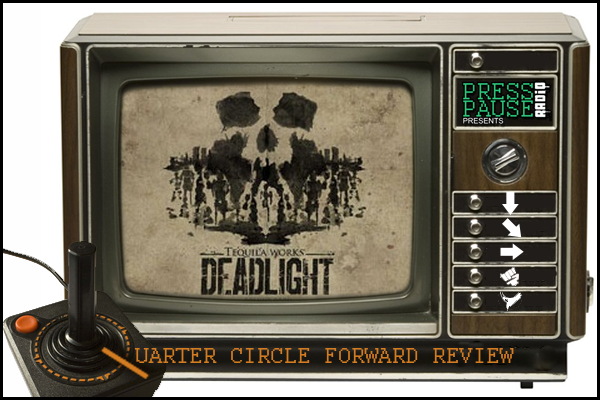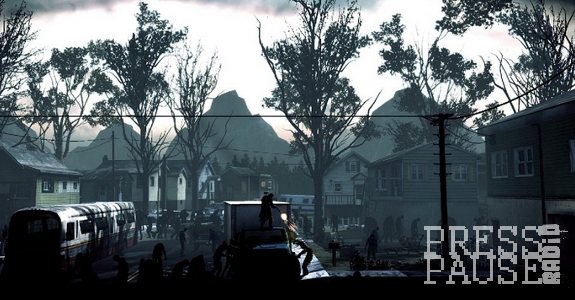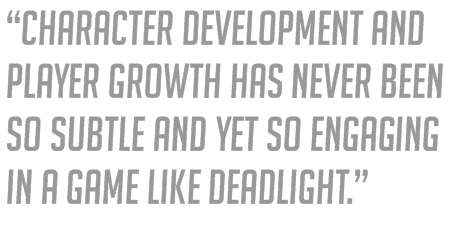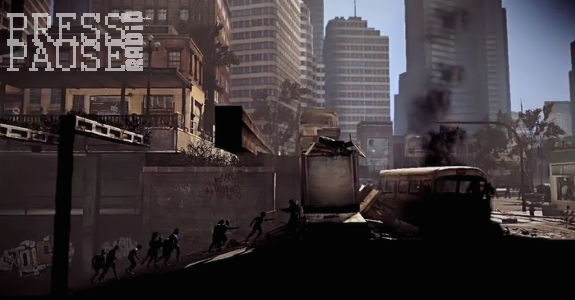QCF: Deadlight

The splintering crash of planks litters the ground as Randal Wayne bursts through and races down the residential streets of Seattle, boring into home after home to escape the ever-growing reach of the undead, the shadows. Microsoft’s Summer of Arcade is in full swing yet again for 2012, and Tequila Works has rolled out their inaugural release, Deadlight for Xbox Live Arcade. Zombie games have far exceeded the threshold of saturation in today’s market, but boasting the talents of individuals with backgrounds ranging from Sony Computer Entertainment Europe to Blizzard Entertainment, Tequila Works managed to infuse innovative yet subtle nuances on the aging side-scroller formula.

The charm of Deadlight is immediate as it is accessible, and it’s all thanks to sharp design going hand-in-hand for both the mechanics and presentation to form a pristine synergy. The setting of an apocalyptic Seattle gradually settles into you as you trek further through its crumbling remains, and successfully enforces the tension conveyed during those pivotal moments of survival. Visuals completely sell the Armageddon, with urban decay spanning far and wide with 2.5D graphics playing the role of zombies to appear from out of nowhere, or backgrounds as effects to the foreground in a cohesive delivery. The score is also accurately composed to represent all of the moody tones for the predicament you find yourself in, and brings the entire experience together. However, the voice acting is rather poor with its dry and forced excecution. In spite of the bad voice acting, the mental registry makes the connection through the deliberate outline of the gameplay mechanics.
Playing as Randal, you have the ability to climb, wall-jump, and grab ledges or fixtures -- reminiscent of Prince of Persia -- in order to progress and survive the numerous hazardous puzzles you encounter. The gruesome anxiety of the punishments you suffer from failing a puzzle hearkens the likes of LIMBO. Randal also possesses a stamina bar that regulates the amount of exertion your body can taking from either sprinting or melee combat, and he also has the ability to verbally taunt “shadows” towards his direction. This skill set exchanged in and out in different combinations seamlessly as you delegate which skill to use to meet whatever demand your situation calls for and ensures that each move you make is deliberate.
 Just to paint a hypothetical scenario, imagine Randal suddenly falling into a room from above. As you regain your composure there’s a group of “Shadows” ahead of you. First observation, you spot an elevated platform behind you. Quickly climbing above it, you then proceed to harass undead foes to come forward and try reaching for you so you may jump over them and avoid a fight. You then proceed to dive over a floor trap and active the power to the room which operates the door to your exit to open, but the floor is electrified and the trap floor behind you will only slow down some of the shadows you evaded only for so long. The pacing from this formula is expertly crafted just from the sheer sense of accomplishment you feel out of the continued play. Advancing deeper into the game makes you feel like your skills progress just by your ability to assess different strategies to your approach at conquering a new set piece you come across from the lessons you experience from the set piece prior. Character development and player growth has never been so subtle and yet so engaging in a game like Deadlight.
Just to paint a hypothetical scenario, imagine Randal suddenly falling into a room from above. As you regain your composure there’s a group of “Shadows” ahead of you. First observation, you spot an elevated platform behind you. Quickly climbing above it, you then proceed to harass undead foes to come forward and try reaching for you so you may jump over them and avoid a fight. You then proceed to dive over a floor trap and active the power to the room which operates the door to your exit to open, but the floor is electrified and the trap floor behind you will only slow down some of the shadows you evaded only for so long. The pacing from this formula is expertly crafted just from the sheer sense of accomplishment you feel out of the continued play. Advancing deeper into the game makes you feel like your skills progress just by your ability to assess different strategies to your approach at conquering a new set piece you come across from the lessons you experience from the set piece prior. Character development and player growth has never been so subtle and yet so engaging in a game like Deadlight.

There are points where this formula doesn’t always resonate with you and you'll fall victim to the trial and error nature of some puzzles requiring initial failure for you to learn how to overcome it. At certain points of the game the camera zooms out to such an extent in order to capture the entire scope of the stage you’re in, and makes the visuals a bit squinty with Randal. Pivotal stage details become a bit too small and muddy to effectively recognize, even if you’re playing with high definition fidelity support. While jumping physics are spot on for effective platforming, hit-detection is a bit too clumsy during enemy combat. Keeping in mind that combat isn’t a focus in Deadlight, and further arguing that the clumsiness of the combat is to imbue authentic sense of fight or flight decision making that will deliver a true survival-horror tension, there are times where it’s just plain faulty and you end up getting shitted on from an encounter you completely had control of. In the face of some of these small shortcomings, the checkpoint system is incredibly forgiving and fast, immersing your right back into the experience.
Deadlight is rather short and can be finished within a couple of sit-downs, but the experience itself is complete and memorable. For only fifteen bones, Deadlight deserves a place in your hard drive.
Four.Five out of Five Hadokens

 22.5D,
22.5D,  Indie Games,
Indie Games,  Summer of Arcade,
Summer of Arcade,  XBLA,
XBLA,  Zombies | in
Zombies | in  QCF Reviews
QCF Reviews 









